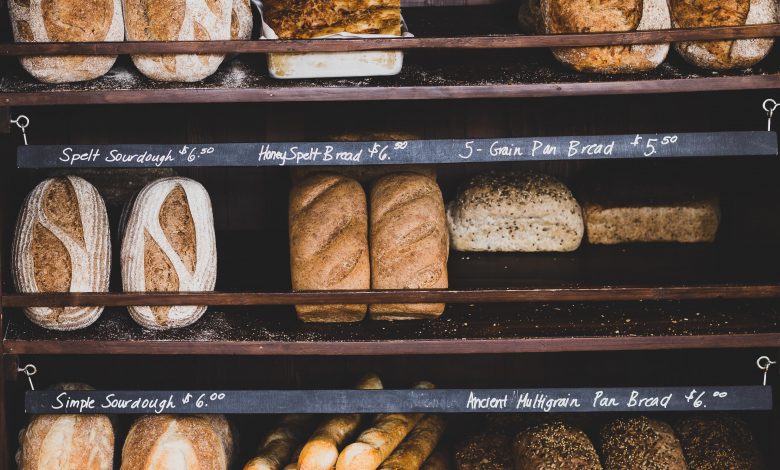
7 Of The Healthiest Bread Options That Are Still Tasty
“Carbs are bad.” This statement is something you have probably nailed into your mind and heart and diligently try to stick to. Low carb diets like the ketogenic diet encourage dieters to stay away from carbs, and unfortunately, that includes an all-time favorite – bread. Although we’ll keep the ‘bad carb’ idea for another time, we’re here to tell you some good news: Not all bread is equal!
If you play your cards right, you could easily keep your favorite bread in your diet without worrying about how many pounds you’ll add on. Particular types of bread that are rich in vitamins, fibers, and minerals are the key to obtaining this.
Instead of following extreme diet trends that ban you from bread entirely, why not consider healthy bread options to incorporate in your diet? The truth is that, if you make the right choice, bread can be a source of needed minerals and vitamins and even aid you in your weight loss journey.
Top 7 Healthy Breads
So what kind of bread is the healthiest? Well, here are our top seven candidates.

1. Sourdough
We agree that its name is far from appealing, but before you judge, you should look beyond its name. Sourdough is different from ‘regular’ bread because of how it is made. Regular bread uses yeast, which reacts with gluten and makes the dough rise like magic. However, sourdough is made using what is called a starter. This starter can be a combination that uses yeast and various types of bacteria that will act as a catalyst. When the bacteria mixes with the dough, it gradually creates lactic acid, which is the exact reason that the dough ends up fermenting.
So how does this process affect its nutritional value? First of all, studies show that the fermentation process that takes place in making sourdough reduces the phytate level while increasing soluble magnesium. If you are trying to get your body to absorb more minerals and nutrients, foods with high phytate levels can bind to minerals like zinc, manganese, and even calcium and slow their absorption.
Another advantage of sourdough is that it is easier to digest compared to other bread. This easy digestion is likely because of its probiotic content. During the fermentation process, good bacteria called probiotics are created. High levels of probiotics are great for digestion and gut health.
Lastly, sourdough is the right choice if you have blood sugar problems or want to keep away from harmful sugars. The lactic acid in sourdough bread gives it a low glycemic index (the measurement of how quickly a food can cause blood glucose levels to rise). Compared to regular bread, sourdough bread converts glucose slowly, which reduces possible spikes in blood glucose levels.
Overall, sourdough bread has more fiber, iron, and other nutrients, making it one of the healthiest bread options available. You can make your sourdough using either whole wheat or white flours.
2. Sprouted Whole Grain
Sprouted whole grain bread is made from whole grains, but the unique characteristic is that these grains have only started to grow.
So what sets sprouted whole grain apart from regular whole grain bread? Whole-grain bread only contains part of the grain, and nutrients, such as fiber, minerals, and vitamins, are removed during the process.
The difference with the sprouted grain is that the whole grain is used, which means higher fiber and nutrients. The germination process increases the nutritional value and the amino acid profile, creating a bread that is easily digested and more nutritious.
The health benefits of sprouted whole grain bread go beyond its nutritional value. Some studies show that the process of sprouting also increases the antioxidants contained in the grain. As with the sourdough bread, the phytate phosphorus content of sprout whole grain bread is lower than regular bread.
In terms of the carbohydrate content, the process used to create sprouted grain bread can reduce the carb content. This means you won’t have to worry about your blood sugar levels spiking after eating this type of bread. Lastly, sprouted whole grain bread has a high fiber and protein content, which means a single slice will take you a long way.
3. Gluten-Free Bread
There are many reasons why you may be following a gluten-free diet. One of the common reasons for pursuing a gluten-free diet is celiac disease. This disease is an autoimmune disorder that prevents the absorption of nutrients from food. If you have celiac disease, gluten-free bread is a necessity.
Usually, gluten-free bread is made without using grains like rye, barley, or wheat but instead uses rice, almond, potato, or corn. Nutrition-wise, there is a lot of assumption that anything gluten-free is right for you, but when it comes to bread, this is far from the truth. Gluten-free flours are highly refined flours and often contain added sugars.
If you are looking for a healthier type of gluten-free bread, look for one that is made from almond or coconut flour. These flours are low in carbs and calories and have high protein, as well as fiber content. Bread with high fiber content helps you feel satisfied for longer, which is excellent for a weight-loss diet.

4. Oat Bread
Oats are suitable for the body; everyone knows this, so it makes sense that anything made from oats should be equally healthy. Oat bread is one example. Usually, oat bread is made by combining oats with whole wheat flour and yeast. Considering the many health benefits of oats, including its high protein, fiber, and mineral content, it is not surprising that oat bread is one of the healthiest options.
According to research, just half a cup of dry oats has minerals like copper, iron, zinc, folate, vitamin B1, manganese, and vitamin B5. Oats are also high in antioxidants, including a unique group called avenanthramides, which can lower blood pressure by increasing nitric oxide production.
A soluble fiber called beta-glucan is also found in high amounts in oats. Beta-glucan can help reduce cholesterol levels, increase satiety, and promote healthy gut bacteria growth. If you find yourself always hungry and craving food (ultimately ruining your diet), oats can help improve your feeling of fullness.
As you may have noticed, all these amazing health benefits are for oats, not necessarily oat bread. So just because you see oats as an ingredient in bread doesn’t mean you’ll get the full benefits of oats. Some bread only contains small amounts of oats and a lot of the bad stuff, like sugars and oils. To make sure you are buying a healthy oat bread, ensure that it lists wheat, flour, and oats among the first ingredients. Or even better, bake your own oat bread!
5. Flax Bread
Like oat bread, flax bread is made by combining flax seeds with whole grain flours. Dubbed as one of the many superfoods, flax seeds offer a wide range of health benefits.
Vegans turn to flax seeds as their source of omega-3 fats, which are known to fight depression and anxiety, improve eye health, and reduce your risk of heart disease.
Flax seeds are also a source of a unique compound called lignans. This compound is believed to have properties similar to estrogen, which can help reduce the risk of cancer. Compared to any other plant food, flax seeds contain up to 800 times more lignans!
Another health benefit of flax seeds is that they can help lower cholesterol levels. In one study, participants who took only three tablespoons of flaxseed powder daily had 17 percent lowered cholesterol after only three months. So if you want to lower your cholesterol levels without hitting the gym, a frequent dose of flaxseed powder may be the answer.
If you are more interested in improving your digestive health, flaxseed bread could very well be your answer. When selecting flaxseed bread, look for a brand that has few ingredients but includes whole wheat and flax seeds among the main.
6. 100% Sprouted Rye Bread
Rye grains are similar to wheat grains but are usually dark and dense. In terms of nutrition, rye is considered a more nutritious grain. One study examined the effect of a rye bread breakfast on hunger and fullness. The results showed that those on rye breakfasts had lower appetites before lunch. Such a decrease in desire continued to affect their eating habits throughout the day.
Another benefit of rye bread is that it has a positive impact on blood sugar levels. Studies show that rye products have the potential to regulate appetite and induce lower insulinemic indexes, which is ideal for those with glucose issues. If you are looking for a bread that won’t cause a spike in your insulin levels, rye bread is a good bet.
The fiber content in rye is also impressive. Only one slice of sprouted rye bread provides three grams of fiber, which can aid in the digestion of carbs and balance glucose levels.
There is a wide variety of rye bread available. However, the healthiest are made from 100% whole grain sprouted rye and may have additional grain flours included. When shopping for rye bread, carefully read the ingredients to make sure you are getting a quality product.
7. 100% Whole Wheat Bread
This is the traditional healthy bread that everyone knows is great for their diet. Whole grains are beneficial for many reasons. For one, they have high fiber content. The bran or the hard outer shell is where most of the fiber is found, and since this is intact in most grains, it is perfect for digestion. Whole grains are also rich in vitamin B, including thiamine, folate, and niacin, as well as minerals like zinc, iron, magnesium, and manganese.
Whole wheat bread can be made from different grains, including wild rice, whole rye, brown rice, barley, buckwheat, wheat berry, popcorn, oatmeal, millet, quinoa, and sorghum.
One of the most significant health benefits with whole grains is their ability to lower your risk of heart disease. In a study that lasted ten years, more than 17,000 adults found that those who ate large portions of whole grains compared to other sources of carbs had a 47 percent risk of heart-related diseases.
Not only are whole grains great for heart health, but they can also lower your risk of stroke. According to six studies involving more than 250,000 participants, those who had a higher whole grain intake had a 14 percent reduced chance of stroke. The reason for this might lie in the vitamin K and antioxidant content in whole grains.
Additional benefits of whole-grain include a lowered risk of developing type 2 diabetes, decreased risk of obesity, better digestion, lowered chronic inflammation, and lowered risk of cancer. However, for those suffering from gluten sensitivity, irritable bowel syndrome, and celiac disease, whole wheat bread is not a healthy choice.

Summing Up the Nutritional Value of Bread
We want to make things easy for you and help you on your journey towards better health. So here is a quick summary of the dietary benefits of these seven healthy types of bread. Each bread is based on one slice, or approximately 46 grams.
| Bread | Calories | Protein | Fat | Carbs | Fiber |
| Sourdough | 120 | 4g | 0g | 20g | 3g |
| Sprouted Whole Grain | 80 | 4g | 0.5g | 15g | 3g |
| Oat Bread | 130 | 6g | 1.5g | 23g | 4g |
| Flaxseed Bread | 80 | 5g | 1g | 14g | 4g |
| Gluten-Free Bread | 90 | 3g | 5g | 6g | 5g |
| 100% Sprouted Rye Bread | 60 | 4g | 1g | 12g | 3g |
| 100% Whole Wheat Bread | 110 | 4g | 0.5g | 25g | 4g |
As the table shows, in terms of caloric content, sourdough is the highest, and 100% sprouted rye bread is the lowest. Gluten-free bread has the least amount of protein, with oat bread exceeding other bread types with an impressive six grams per slice.
Sourdough contains the most moderate fat, while gluten-free bread has the highest. The carbohydrate content of oat bread is high, and gluten-free bread offers the least amount of carbs. Lastly, in terms of fiber, sourdough, sprouted whole grain and sprouted rye bread all have similar fiber, but gluten-free bread has the highest.
Tips For Choosing The Healthiest Bread
Since not all of us have the time or skill to bake our healthy-version of these bread types, it pays to know how to sift the good from the bad when you are a store. Although we aren’t promoting any particular brands of bread, we can tell you what to look for:
- No sweeteners added
- Healthy ingredients like sprouted flours or whole grain listed first (ingredients are listed in descending order based on the quantity)
- A high fiber (about two grams or more per slice) and protein content
Aside from these three essential tips, make sure you find the word “100%” or “whole.” When looking at the ingredients list, do not fall for anything that says “enriched,” “multigrain,” or “unbleached wheat flour,” which are basically deceptive ways that refer to white flour.
Another important thing you should understand is the meaning behind the words whole grain. You will read many packages claiming to be whole-grain, but only a few will be genuine. When a product says it is whole grain, it means it has all three parts of the kernel – namely, the bran, germ, and endosperm. Also, the product has at least 51 percent of whole-grain ingredients per serving.
You may also encounter bread brands that use “white whole wheat” or “whole grain white” that may sound healthy. White whole-wheat bread is made from a variety of albino wheat, which contains the same nutritional value as full wheat flour. The only difference is that the white whole wheat is milder in taste and texture. White whole wheat is a good option for kids or others who don’t like the heavy feeling of whole wheat bread.
Nowadays, loaves of bread have a long list of ingredients that shouldn’t be there but help improve taste and increase shelf life. Additions like sugar, corn syrup, or honey can be used to make the bread sweeter. Some manufacturers will claim that their bread is ‘enriched’ with vitamins and minerals to help them appear healthier. The secret is knowing what you are willing to accept and which ingredients are a big no for you.
Making Your Choice
Since bread is one of the staples in many countries, it is challenging to remove it from your diet. If you want to lose weight or simply want to make healthier choices, the best option is examining the type of bread you buy.
There are many reasons why many diets tell you to stay away from bread. In general, bread has low essential nutrients and high calories. Another disadvantage with most breads is that they contain gluten, which some people can’t tolerate. The high carbohydrate content of bread is another challenge that tends to increase blood sugar levels that may make you feel hungry, increasing the chances of overeating. Grains are also known to harbor so-called anti-nutrients that block your body from absorbing certain minerals.
Despite all the negative effects of traditional bread, the fact is that not all bread is equal. If you do your research and find the right type of bread to fit your fitness goals, you can still enjoy it while gaining numerous health benefits. Selecting the correct kind of bread which contains wholesome ingredients can have a positive impact on your health.
Healthy slices of bread can:
- Reduce blood pressure
- Lower cholesterol
- Improve heart health
- Boost digestion and gut health
- Reduce your risk of cancer
- Lower your risk of heart disease and stroke
- Increase feelings of satiety
- Provide needed nutrients, vitamins, and minerals for your body
The secret is balance. Whichever type of healthy bread you choose, make sure you eat it alongside other healthy fruits and vegetables. Having a balanced diet that includes healthy bread choices will go a long way in helping you make your weight loss dreams a reality



